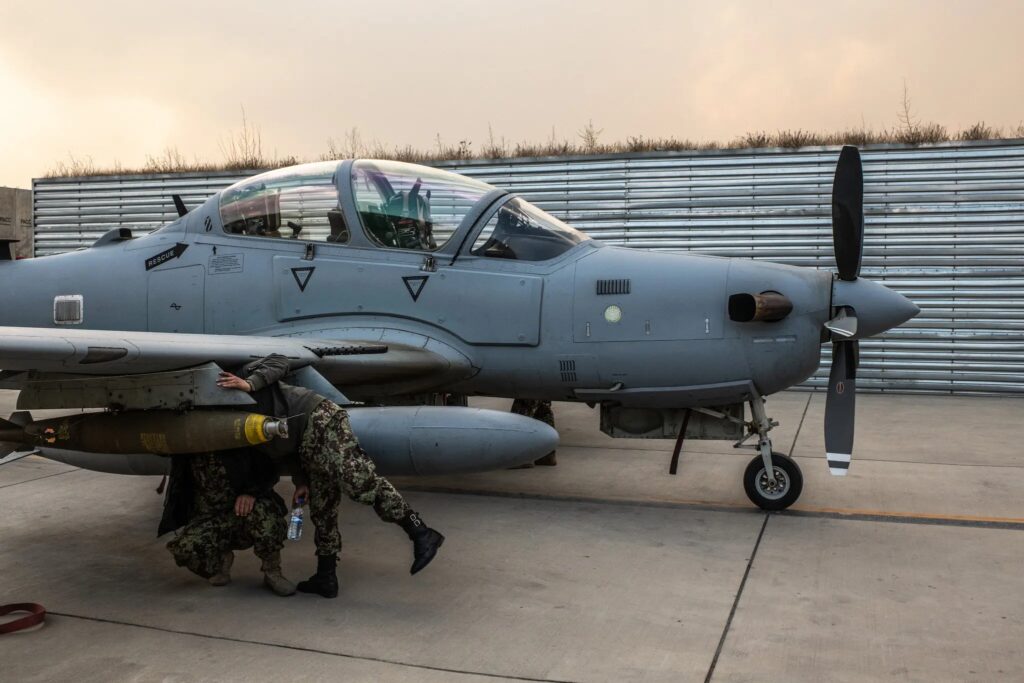Afghan Pilots Who Escaped Taliban Are Flown Out of Tajikistan

More than 140 Afghan Air Force pilots and crew members were evacuated to the United Arab Emirates three months after flying into Tajikistan to escape the Taliban.
More than 140 Afghan Air Force pilots and crew members detained in Tajikistan since mid-August after fleeing Afghanistan were flown out of the country Tuesday with the help of the American authorities.
The flight, bound for the United Arab Emirates, ended a three-month ordeal for the U.S.-trained military personnel, who had flown American-supplied aircraft to Tajikistan to escape the Taliban only to end up in custody.
The Afghans said they were counting on the U.S. government to secure their freedom after they were detained by the Tajik authorities after the Taliban seized power in their home country and they fled, fearing reprisals.
In WhatsApp audio recordings made on smuggled cellphones, the English-speaking pilots described poor conditions, insufficient food rations and limited medical care at the site where they were being held outside the capital, Dushanbe.
Brig. Gen. David Hicks, a retired Air Force officer who is chief executive of Operation Sacred Promise, said a plane carrying the Afghans had departed Dushanbe on Tuesday night, U.S. Eastern time, after a long delay.
“It’s just such a great relief for the entire team knowing that they are getting out of this period of uncertainty and taking the first step in starting their new lives,” General Hicks said. “Hopefully, they will all be reunited with their families soon.”
On Wednesday morning, the State Department confirmed through a spokesman that on Tuesday a “group of approximately 191 Afghans” had been relocated via a charter flight organized by the United States government from Dushanbe to the United Arab Emirates, “where they will temporarily remain for processing prior to onward travel.”
But for many Afghans who worked with the U.S. military, the ordeal is not over.
Several thousand Afghan Air Force pilots and crew members remain in hiding in Afghanistan, with some saying they feel abandoned by the U.S. military, their longtime combat ally. They say they are desperate to leave Afghanistan because they and their families are at risk of being hunted down and killed by the Taliban.
In telephone interviews from safe houses in Afghanistan, several Afghan Air Force pilots described moving from house to house to avoid detection. They said they were running out of money and did not dare look for work because they feared being discovered by the militants.
The Taliban have said there is a general amnesty for any Afghan who served in the former government or worked with the U.S. government or military. But several Afghan Air Force pilots have been killed by the Taliban this year.
General Hicks said the State Department also had aided in the evacuation in September of a separate group of Afghan pilots and crew members who had flown to Uzbekistan. Those Afghans also were taken to a U.S. military base in the United Arab Emirates.
The Taliban had pressured Uzbekistan to return the pilots and crew members to Afghanistan.
Many Afghan pilots were trained in the United States to fly U.S.-supplied military planes and helicopters. The United States spent more than $8 billion to train and equip the Afghan Air Force, but the pilots and planes were overwhelmed by the demands of supporting a U.S.-trained army that quickly collapsed as the Taliban toppled one provincial capital after another this summer.
Some pilots and crew members and their families were evacuated with the help of the U.S. government and military just after the Taliban takeover in August. But many more were unable to get out, despite attempts by their former advisers to help them.
Since mid-August, General Hicks said, Operation Sacred Promise has helped evacuate about 350 Afghans. The group has vetted about 2,000 Afghan Air Force personnel and their relatives trying to leave Afghanistan, with about 8,000 more still to be vetted, he said.
The status of the Afghan Air Force aircraft flown to Tajikistan and Uzbekistan remains unclear.
During Afghanistan’s collapse, about 25 percent of the Afghan Air Force’s aircraft were flown to Tajikistan and Uzbekistan, according to an Oct. 31 report by the Special Inspector General for Afghanistan Reconstruction. General Hicks put the number at 56 to 60 aircraft.
U.S. forces rendered unusable 80 others at Kabul’s airport in late August.
